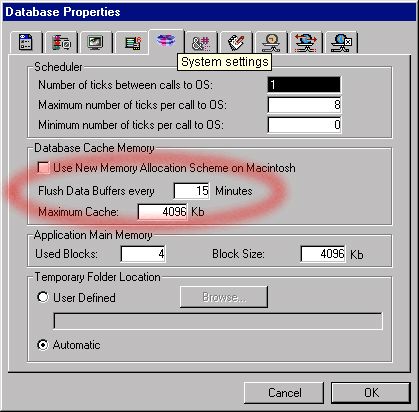Tech Tip: Relocated Flush Data Buffers Setting
PRODUCT: 4D | VERSION: 6.5 | PLATFORM: Mac & Win
Published On: August 18, 2000
In the Database Properties dialog, the setting for "Flush Data Buffers every ... Minutes" has been relocated.
In version 6, this setting was located on the "Data Control and Access" page, in the "Data Control" section.
In version 6.5, this setting has been relocated to the "System settings" page, in the "Database Cache Memory" section.

When you add, change, or delete records, the changes aren't immediately written to disk, but are instead held in a buffer in memory. This is done to speed up the operation of the database. Periodically, these changes are written to disk. The "Flush Data Buffers..." setting allows you to specify the time interval between these disk writes. You can set the interval between 1 and 120 minutes.
While the data buffers are being written to disk, all other operations in the database are temporarily suspended. If you find that this buffer flushing is taking a very long time, you should decrease the Flush Data interval, so that your buffer flushes will be more frequent, but of shorter duration. One reason you want to avoid long buffer flushes is that when the other database operations are suspended for a long time, the users may mistakenly think the computer has crashed, and take drastic measures such as force-quitting the program or powering off the computer, which can cause you serious problems.
On the other hand, you don't want the buffer flushes to occur too frequently, because unnecessarily increased disk activity can slow down your database.
The best time interval setting will vary from one database to another, depending on the volume and the frequency at which records are being changed.
For more information on this, see page 93 in Chapter 1 of the 4D v6.5 Design Reference Manual, which you can download (11,249K pdf format) from our ftp site.
In version 6, this setting was located on the "Data Control and Access" page, in the "Data Control" section.
In version 6.5, this setting has been relocated to the "System settings" page, in the "Database Cache Memory" section.

When you add, change, or delete records, the changes aren't immediately written to disk, but are instead held in a buffer in memory. This is done to speed up the operation of the database. Periodically, these changes are written to disk. The "Flush Data Buffers..." setting allows you to specify the time interval between these disk writes. You can set the interval between 1 and 120 minutes.
While the data buffers are being written to disk, all other operations in the database are temporarily suspended. If you find that this buffer flushing is taking a very long time, you should decrease the Flush Data interval, so that your buffer flushes will be more frequent, but of shorter duration. One reason you want to avoid long buffer flushes is that when the other database operations are suspended for a long time, the users may mistakenly think the computer has crashed, and take drastic measures such as force-quitting the program or powering off the computer, which can cause you serious problems.
On the other hand, you don't want the buffer flushes to occur too frequently, because unnecessarily increased disk activity can slow down your database.
The best time interval setting will vary from one database to another, depending on the volume and the frequency at which records are being changed.
For more information on this, see page 93 in Chapter 1 of the 4D v6.5 Design Reference Manual, which you can download (11,249K pdf format) from our ftp site.
